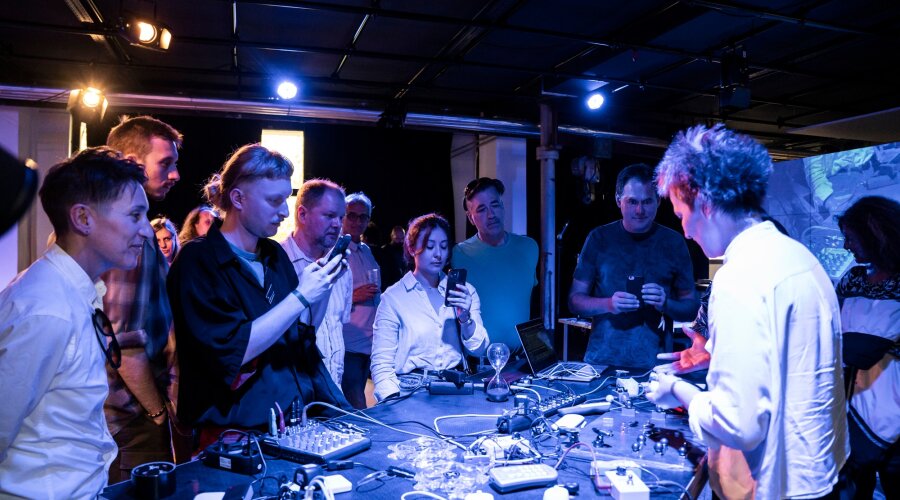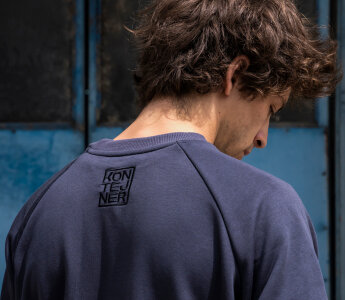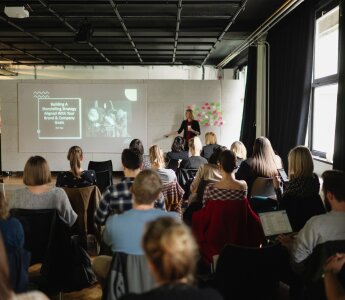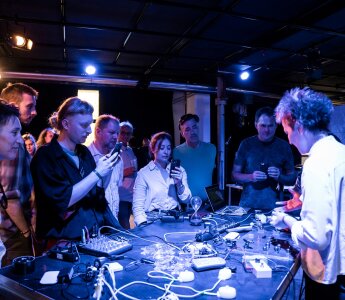How can digital arts organisations bring in a business mindset while maintaining artistic integrity as major producers of digital art? DI/S - Digital Inter/Section, a project supported by the Creative Europe programme of the European Commission, has released four case studies with new business models aimed at supporting digital arts organisations and the creative sector.
Some of the key findings include a strong audience perspective and the fact that funding through diversified income sources—whether public or private—leads to greater stability and sustainability.
The Zagreb case study is about experimenting with economic sustainability and community engagement for KONTEJNER’s new venue, a centre for contemporary art practices. A key takeaway from this case study is that innovative practices and development can be turned into a catalyst for a new organisational ecosystem that favours circular economy models and social entrepreneurship, generating new benefits for the broader cultural sector. Introductions and links to the full case studies below.
The Four Case Studies by DI/S - Digital Inter/Section
KONTEJNER, Zagreb, Croatia
Experiments with sustainable venue management
The Zagreb case study revolves around experimenting with economic sustainability and community engagement for KONTEJNER’s new venue, a small centre for contemporary art practices.
The goal for KONTEJNER was to create more sustainable and diversified funding to support its new venue, and to foster community development by reaching new audiences and partners and converting them into supporters of the venue.
KONTEJNER developed and tested a series of experimental actions, including launching a new company, monetizing spatial resources, and designing membership packages for citizens and partners. A key takeaway from this case study is that innovative practices and development can be turned into a catalyst for a new organisational ecosystem that favours circular economy models and social entrepreneurship, generating new benefits for the broader cultural sector.
The Zagreb pilot project is all about experimenting with sustainable venue management. We wanted to strengthen connection with our existing audiences while reaching new ones. The membership packages for our audiences are tailored to turn them into contributors. – Jadrana Ćurković, Communication and marketing consultant
Chroniques, Marseilles, France
Market of Digital Imagination Fair
The Market of Digital Imagination Fair (Marché des Imaginaires Numériques - MIN) is an event for professionals in the cultural and creative industries focused on new technologies and digital creation.
The marketplace deepens the connection between art and technology, fosters R&D, and cultivates innovative partnerships. Building on the Biennial of Digital Imaginaries, an artistic event, MIN capitalises on the organisation’s ability to break down barriers and bring different economic sectors together.
By connecting artists, tech innovators, and cultural leaders, it is exploring sustainable models for visibility and collaboration. Chroniques is hybridizing its revenue streams by generating B2B revenue and by developing a customer-centric approach.
A key takeaway from this case study is that the development of MIN supports Chroniques’s advocacy to convince public decision-makers of its cross-sectoral role, by mobilising public funds earmarked for economic growth, not only for the cultural sector.
Pay special attention to the community and the international audience, as it is important to always envision the possibility of bringing people together to exchange ideas and develop new projects. – Bianca Farrugia, Production manager at MIN and Céline Berthoumieux, Co-director of Chroniques
KIKK, Namur, Belgium
Klub Pavillon
Klub Pavillion raises awareness of sponsorship dedicated to digital creativity through the creation of a members' club that supports a new exhibition space.
In 2022 KIKK opened an exhibition space in Namur (Belgium) dedicated to the digital experience that increased the organisation's dependence on public funding. To reduce this dependence, KIKK has looked into developing new private support through a members' club, based on adherence to the project and its values, that guarantees a unique offer to members while securing funding for an exhibition space for digital art that is open around the year.
A couple of takeaways from this case study are the importance of strategic analysis to align the club’s offer with the Pavillion’s programme and of working towards a deadline and a fixed sum for the Pavillion Klub patronage. In 2020 we decided to make a transition from an event-based model to a permanent structure. Now we have opened a space for public awareness where accessibility of content is the key. – Gilles Bazelaire CEO and Founder
Our first challenge was to conduct an audit of our meaningful and significant offering, and to map our network of potential partners and members. As a small organisation, we need to leverage what already exists and ensure a good balance between sponsorship packages and talent offerings with some of the selected partners. – Chloé Gerard, Partnership Manager
Signal Festival, Prague, Czech Republic
New business model targeting ticketing and audience strategy
The goal of the pilot project carried out by Signal Festival was to ensure long-term financial sustainability and enhance the visitor experience through the optimization of ticketing models, improved audience segmentation, and the redefinition of premium products such as the Gallery Zone.
Signal Festival, the largest digital art festival in the Czech Republic that draws 500,000 to the streets of Prague, is evolving its business model to reduce reliance on public funding. It is focusing on premium experiences and data-driven segmentation to ensure long-term sustainability and a deeper connection with its diverse audience.
A key takeaway from this case study is that by targeting both mass and niche audiences, the festival aims to secure long-term growth while maintaining artistic integrity and developing visitor experiences - thus putting audience perspective and artistic integrity at the centre.
First, diversify your revenue streams. Explore paid options for your audience to complement B2B partnerships and public funding. Invest in understanding your audience. Research into visitor behaviour and expectations gives you the insights needed to create real value. Work with qualified experts. Collaboration with professionals, like our research agency, was key in validating data accurately. – Martin Pošta, CEO
Signal Festival is committed to sustainability. We strive to minimize our environmental impact by digitizing the ticketing process, reducing waste and through recycling sourcing locally. We also educate our visitors about environmental issues through our artworks. – Alzbeta Krajcikova, Program Manager
Strengths and Challenges
The digital arts organisations that came together to form DI/S are diverse, yet they share many strengths and face similar challenges. They are united by a deep understanding of digital society and experience-based environments, as well as strong networking and collaborative skills. However, they grapple with identifying new revenue streams without compromising their creative integrity and with introducing a business mindset in organisations that are partially publicly funded.
The local pilot projects demonstrate that digital arts organisations and private companies can align on shared interests and mutually guide each other toward new narratives, opportunities, and knowledge. This collaboration contributes to their respective economic growth and offers innovative ways to implement Corporate Social Responsibility (CSR) policies.
The Impact of Digital Arts Organisations
Digital arts organisations are reaching wide audiences through biennials and festivals. With expertise in experience-based environments, digital society, and digital literacy, they are hybrid entities operating through complex income streams—from public funding to private and self-generated sources. Positioned at the forefront of the digital revolution, these organisations bring expertise that extends beyond the traditional scope of arts institutions. Their impact goes beyond the creative sector, promoting a cross-disciplinary approach that bridges creativity, technology, science, and community, all while upholding strong values and artistic integrity.
Key opportunities that have been identified:
→ experience-based environments
→ hybridity
→ understanding of digital society
→ digital literacy
→ collaborative ecosystem











